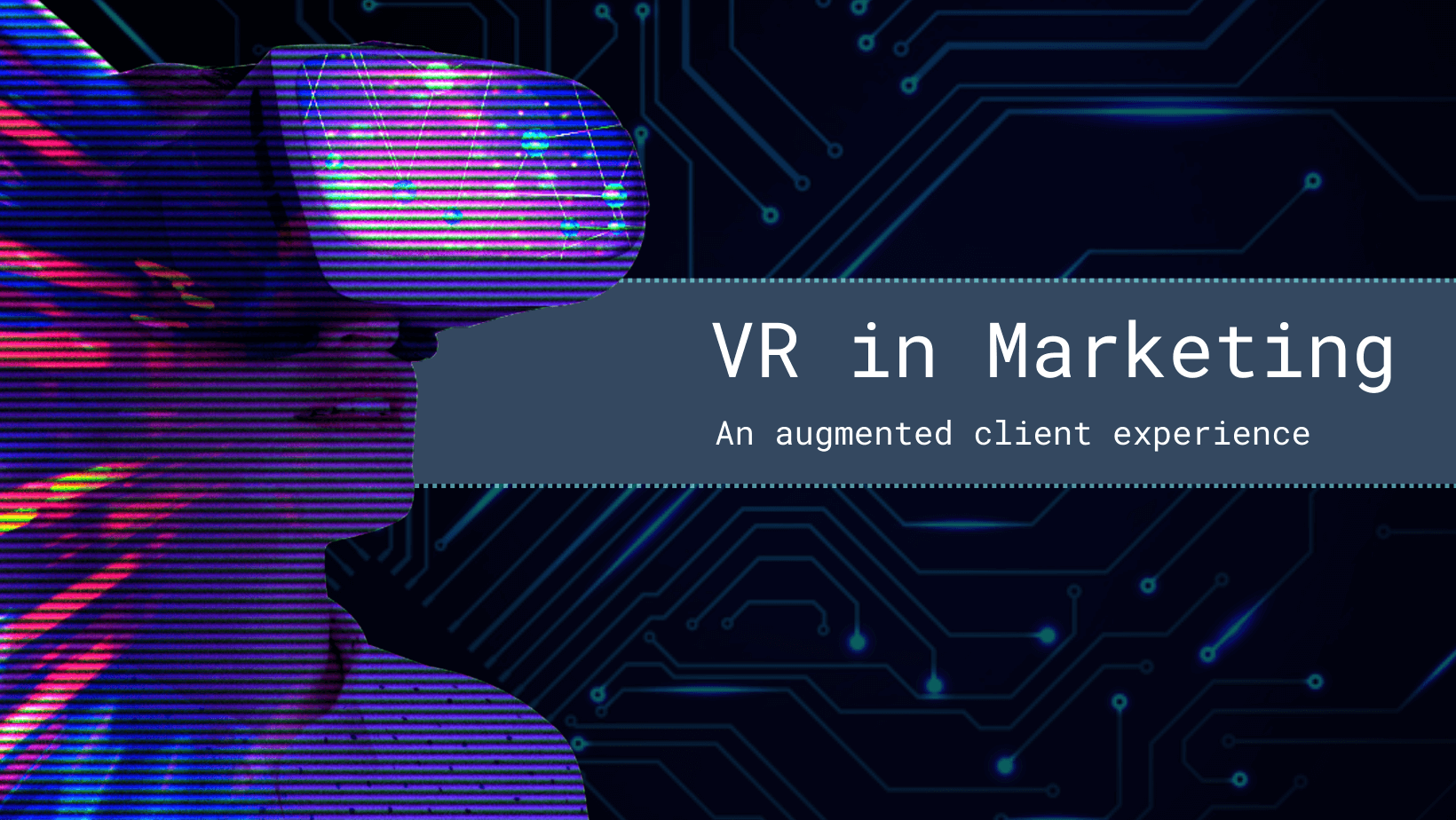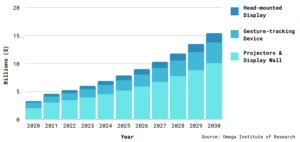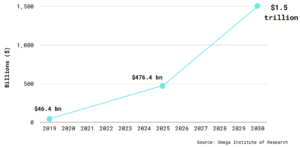- Industries
Industries
- Functions
Functions
- Insights
Insights
- Careers
Careers
- About Us
- Marketing & Advertising
- By Omega Team

Virtual reality marketing involves brands promoting themselves and their products using virtual and augmented reality technology. Sometimes VR marketing is visual, and sometimes it’s multi-sensory, depending on the device. A full virtual reality headset offers a completely immersive experience, while a VR Instagram filter simply overlays objects or pictures onto the camera view. These filters are a type of augmented reality (AR) marketing. AR is a type of virtual reality in which a virtual image is overlaid in the real world.
Branded collectively as immersive media, along with augmented reality, virtual reality marketing offers notable opportunities for businesses to promote their brands, drive sales, and enhance customer loyalty and retention.
Figure 1: US Virtual Reality Market Size, by device, 2020-2030 (USD Billion)

VR Global Market
VR is here and it’s gaining traction fast. With a 2021 market size of more than USD 21 billion, virtual reality is expanding at a steady rate and it’s expected to have a compound annual growth rate of 15% within a 10-year period (2022 to 2030).
The use of VR is expected to grow with time, along with other digital technologies like augmented reality. PwC predicts that by 2030, VR and AR can potentially boost the global GDP to USD 1.5 trillion.
Figure 2: Effect of AR and VR on global GDP by 2030

How VR helps to optimize marketing and Branding Activities
1. Elevated Social Shopping Experiences
We are seeing social media incorporate VR technology and take the social shopping experience to new heights. Snapchat is leading the way, and it’s making serious investments to make AR shopping a reality. This is the next step for social media marketing, as these innovations can elevate the online shopping experience and entice users.
2. Immersive PR Outreach to Journalists
From a PR perspective, VR and AR are creating unprecedented opportunities for journalists to experience clients’ offerings in new and immersive ways that bypass the traditional media familiarization trips and desk sides. Now, events, facilities, properties, travel destinations and more can all offer journalists an opportunity to discover what makes them special without coordinating a visit or trip.
3. AR/VR Brand Interactions and App Integrations
The coronavirus has left many people unwilling to interact with brands at major shopping centers and expos. Online product listings and reviews can now be considered alongside AR/VR brand interactions. As top tech players such as Google make AR integrations for nearly all apps, it would be unwise to discount this futuristic technology as far-off.
4. Using VR to tell your story
Traditional media like TV and films are great storytelling mediums. However, VR takes storytelling capabilities a step further. Businesses can use VR to tell their brand stories and market their solutions in a more engaging way. For example, the New York Times used virtual reality to tell the story of how wars affect children in The Displaced. Through this multimedia experience, users were given an in-depth look into the devastation caused by wars and what it’s like to be a child displaced by such life-changing events. The experience allowed the NYT’s readers to see what’s really happening, making VR and the documentary potent storytelling mediums that provide not only emotional intensity for readers but also a connection with the brand.
5. Adding the element that excites the viewers
Traditional ads can get boring fast. They don’t create memorable experiences and some ads, such as pop-ups, can feel spammy and even drive away potential customers. On the contrary, VR can help to add the element that can engage the audience. Volvo, for example, leveraged VR to showcase the Volvo XC90. Through the Volvo Reality app, users can enjoy a virtual reality test drive of the model and get a firsthand look at the car’s interiors.
6. More Empowered Pre-decision-making Processes
The VR/AR movement has really given PR and marketing a boost. It allows for a data-driven, scientific approach to strategy as well as to the derived result. AI empowers the pre-decision-making process by accurately placing consumer sentiment. It has to be the right balance of EQ and IQ, which is why an agency with considerable experience can add immense value to its marketing efforts using VR and AR.
7. Reinforcing the “try before you buy” concept
Allowing users to try on a product before purchase helps them make more informed decisions. Companies are using VR to let users try on clothes, makeup, accessories, and even furniture without going to a physical store.
Walmart is using an AI-powered virtual try-on technology for consumers who are shopping for clothes online. This feature uses AI technologies such as real-time image processing and deep learning to create a simulation that helps buyers to see what clothes would look like on them. Users can select a model that closely matches their height and size and use that to virtually try on a range of Walmart’s clothing offerings.
Glasses are also big on the virtual try-on trend. Lenskart also enables its users to virtually try on a range of eyeglasses and sunglasses using their phone or by uploading their photos.
8. VR Marketing and Influencers
As VR continues to gain traction, it will undoubtedly affect digital marketing strategies. We’re already seeing the rise of AI-powered virtual influencers, which are digital avatars or 3D models that can be found on various social media platforms. These virtual influencers are built by creators and act like their human counterparts.
Many brands, such as Prada and Alibaba, are using top virtual influencers to enhance their campaigns and drive more engagement. Virtual influencers also help brands stay on top of the latest innovations and tap into the interests of their younger audiences. Moreover, like their human counterparts, virtual influencers can help with building brand awareness.
Where does this leave human influencers?
Human influencers are already embracing virtual reality and augmented reality through app filters, creating branded content in the process, and virtual concerts. The advent of immersive technologies will propel influencer marketing to newer heights. This will drive influencers to change how they create content, taking into account VR and AR technologies through content like live streaming digital reality interactions or creating 360-degree live content that still allows their followers to interact with them.
Case Studies
1. Adidas
Adidas partnered with Somewhere Else, an emerging tech marketing agency, to follow the mountain-climbing journey of two extreme athletes sponsored by TERREX (a division of Adidas).
Both companies partnered to give their audience a 360-degree view of the journey. Viewers were able to follow the climbers, Ben Rueck and Delaney Miller, literally rock for rock and climb along with them. Using a VR headset and holding two sensory remote controls in each hand, viewers could actually scale the mountain of Delicatessen right alongside Rueck and Miller.
This VR campaign, according to Somewhere Else, served to “find an unforgettable way to market TERREX, [Adidas’s] line of outdoor apparel & accessories.” What the company also did, however, was introduce viewers to an activity they might have never tried otherwise. Instill an interest in the experience first, and the product is suddenly more appealing to the user.
2. L’Oreal
Makeup and hair-care brand L’Oreal released an app called Makeup Genius, much like Sephora’s Virtual Artist. L’Oreal Makeup Genius lets you try out a variety of hair colors and makeup styles.
Virtual try-on is also a way to address safety concerns brought on by the coronavirus pandemic. Customers can test makeup without using the shared samples that were often available in stores. In fact, they can try out and buy products without venturing to in-person stores at all. Customers have certainly found the value in L’Oreal’s app: it has been downloaded over 20 million times.
Makeup Genius works on both mobile and desktop devices, making it widely accessible. As customers try out new looks, the app offers personalized recommendations and sends alerts when new products become available. Companies should strongly consider following suit and using VR to create customized shopping experiences based on customer preferences. An Accenture survey found that 91% of consumers prefer brands that provide personal recommendations.
3. Gucci: Try On Shoes
Luxury apparel brand Gucci launched an AR feature in its app to promote the new line of Ace sneakers. Users can point the camera at their feet and see how different styles of sneakers would look. The app tracks movement, so they can see the shoes from multiple angles.
The company later added the technology to Snapchat, opening up a whole new venue for user-generated content (UGC). Putting the filter in Snapchat reduced friction for customers because they didn’t have to download Gucci’s app to try it out. Using AR with Snapchat also offers a new venue for sales. About 50% of Gucci sales are from millennials. Since Snapchat is popular among millennials, Gucci’s target audience can try out products by using a platform they already use every day.
When customers can use virtual reality to try out the products, you get all the benefits of sending out free samples, without the cost and hassle.
4. Prada
Luxury clothing brand Prada created a Stories filter that turns the letters of PRADA into an acronym as part of a larger 2020 campaign.
When people use the filter, a white sign appears behind them, saying “Current Prada mood.” The sign then rotates through a series of acronym sets before landing on one at random.
The filter adds a game-like feeling to the user’s Story video since they don’t know what set of words they might get. It creates a sense of fun for users, so they’re motivated to add the filter to their Stories.
Conclusion
With virtual and augmented reality, one can offer your customers a unique perspective. They can try out dozens of products in minutes to find the best possible fit, or they can see firsthand the social impact their purchases have.
But the best part is that virtual reality marketing is achievable even for small businesses. Custom Instagram AR filters are free. And thanks to widely available technology like Apple’s ARKit, even creating one’s own augmented reality app is reasonable.
Now is the time to embrace VR and AR marketing. The technology is affordable and widely available, but it’s still new enough to give you an edge over your competitors.
Subscribe
Select topics and stay current with our latest insights
- Functions